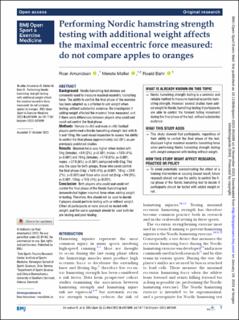| dc.contributor.author | Amundsen, Roar | |
| dc.contributor.author | Møller, Merete | |
| dc.contributor.author | Bahr, Roald | |
| dc.date.accessioned | 2024-02-09T10:23:44Z | |
| dc.date.available | 2024-02-09T10:23:44Z | |
| dc.date.created | 2023-12-12T19:34:33Z | |
| dc.date.issued | 2023 | |
| dc.identifier.citation | BMJ Open Sport & Exercise Medicine. 2023, 9(4), Artikkel e001699. | en_US |
| dc.identifier.issn | 2055-7647 | |
| dc.identifier.uri | https://hdl.handle.net/11250/3116577 | |
| dc.description | This is an open access article distributed in accordance with the Creative Commons Attribution Non Commercial (CC BY-NC 4.0) license, which permits others to distribute, remix, adapt, build upon this work non-commercially, and license their derivative works on different terms, provided the original work is properly cited, appropriate credit is given, any changes made indicated, and the use is non-commercial. | en_US |
| dc.description.abstract | Background: Nordic hamstring test devices are commonly used to measure maximal eccentric hamstring force. The ability to control the final phase of the exercise has been adopted as a criterion to add weight when testing, without substantial evidence. We investigated if adding weight affected the maximal force measured, and if there were differences between players who could and could not control the final phase.
Methods: Female (n=84) and male (n=56) football players performed a Nordic hamstring strength test with 0, 5 and 10 kg. We used visual inspection to assess the ability to control the final phase (approximately last 20°), as per previously published studies.
Results: Maximal force was higher when tested with 5 kg (females: +8 N (2%), p<0.001; males: +18 N (4%), p<0.001) and 10 kg (females: +17 N (5%), p<0.001; males: +27 N (6%), p<0.001) compared with 0 kg. This was the case for both groups, those who could control the final phase (5 kg: +16 N (4%), p<0.001; 10 kg: +28 N (7%), p<0.001) and those who could not (5 kg: +9 N (3%), p<0.001; 10 kg: +15 N (4%), p<0.001).
Conclusion: Both players who could and could not control the final phase of the Nordic hamstring test demonstrated higher maximal force when adding weight to testing. Therefore, this should not be used to decide if players should perform testing with or without weight. Either all participants or none should be tested with weight, and the same approach should be used both for pre-testing and post-testing. | en_US |
| dc.language.iso | eng | en_US |
| dc.subject | eccentric | en_US |
| dc.subject | football | en_US |
| dc.subject | hamstring | en_US |
| dc.subject | injury | en_US |
| dc.subject | prevention | en_US |
| dc.title | Performing Nordic hamstring strength testing with additional weight affects the maximal eccentric force measured: Do not compare apples to oranges | en_US |
| dc.type | Peer reviewed | en_US |
| dc.type | Journal article | en_US |
| dc.description.version | publishedVersion | en_US |
| dc.rights.holder | © Author(s) (or their employer(s)) 2023 | en_US |
| dc.source.pagenumber | 6 | en_US |
| dc.source.volume | 9 | en_US |
| dc.source.journal | BMJ Open Sport & Exercise Medicine | en_US |
| dc.source.issue | 4 | en_US |
| dc.identifier.doi | 10.1136/bmjsem-2023-001699 | |
| dc.identifier.cristin | 2212640 | |
| dc.description.localcode | Institutt for idrettsmedisinske fag / Department of Sports Medicine | en_US |
| dc.source.articlenumber | e001699 | en_US |
| cristin.ispublished | true | |
| cristin.fulltext | original | |
| cristin.qualitycode | 1 | |
